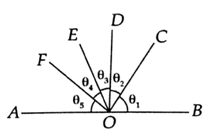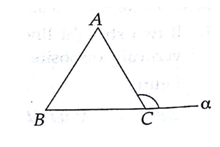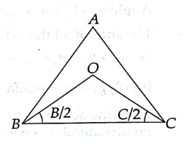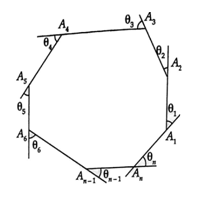Lines and Angles
Fundamental terms and Definitions:
- Line segment and ray: The part of a straight line whose both ends are fixed is called a line segment. If one point of a line is fixed, it is called a ray.
- Collinear points and Non-collinear points: If three or more points lie on a straight line, they are called collinear point. If three or more points do not lie on a straight line, they are called non-collinear points.
- Types of angles: According to measurement, angles are of following types.
- Acute angle: If an angle lies between 0° and 90°, it is called an acute angle.
- Right angle: An angle whose measurement is 90° is called a right angle.
- Obtuse angle: If an angle lies between 90° and 180°, it is called obtuse angle.
- Straight angle: An angle whose measurement is 180° is called a straight angle.
- Reflex angle: If an angle lies between 180° and 360°, it is called Reflex angle.
- Complementary angles and Supplementary angles: If sum of two angles is equal to 90°, they mutually formed a set of complementary angles; e.g., Complementary angle of 30° is 60° and Complementary angle of 60° is 30°.
If sum of two angle is 180°, they are called supplementary to each other; e.g. Supplementary angle of 60° is 120° and supplementary angle of 120° is 60°.
- Adjacent angles: Two angles are said to be adjacent angles if they have a common vertex, a common side and their uncommon sides are situated at two different sides of the common side.
In the adjacent figure ∠EBC and ∠DBC are adjacent angles because point B is common to both of them and their uncommon sides BD and BE are opposite to the common side BC.

Similarly ∠DBC and ∠DBA are adjacent angles, but ∠EBC and ∠DBA are not adjacent angles as they donot have a common side.
- Linear pair of angles: In the adjacent figure ∠AOC and ∠COB are adjacent angles and AOB is a straight line i.e., uncommon sides of adjacent sides form a straight line. Such angles are called linear pair of angles.

- Vertically opposite angles: If two straight lines AB and CD intersect each other at point O, then angles facing each other is called vertically opposite angles.
In the adjacent figure, ∠AOD and ∠BOC are one pair of vertically opposite angles, while ∠AOC and ∠BOD are another pair of vertically opposite angles.

- Transversal line: A straight line intersecting two or more lines at different points is called a transversal line.
In the given figure straight line n intersects two different lines l and m respectively at point P and Q, so line n is a transversal line.

- Exterior angles and Interior angles: In the figure given below, a transversal line n intersects two straight lines l and m respectively at P and Q. Around each point P and Q, four angles are formed, among these angles ∠1, ∠2, ∠7, ∠8 are called exterior angles while ∠3, ∠4, ∠5, ∠6 are called interior angles.

- Corresponding angles and Alternate angles: In the figure drawn above
- ∠1 and ∠5, ∠2 and ∠6, ∠3 and ∠7 and ∠4 and ∠8 are called pair of corresponding angles.
- “∠4 and ∠6” and “∠3 and ∠5” are called pair of alternate interior angles.
- ∠1 and ∠7″ and “∠2 and ∠8” are called alternate exterior angles.
- ∠4 and ∠5″ and “∠3 and ∠6” are called consecutive interior angles or Alternate interior/exterior allied angles or co-interior angle.
All type of alternate angles are commonly known as alternate angles.
- Exterior angle and Interior opposite angle of a triangle: In the adjacent figure sides BC, CA and AB of triangle ABC are respectively produced to points D, E and F. ∠ACD, ∠BAE and ∠CBF thus formed are called exterior angles of the triangle.
Interior angles ∠A and ∠B are called interior opposite angles to the exterior angle ∠ACD. Similarly ∠B and ∠C are interior opposite angles to the exterior angle BAE etc.

- Types of triangles according to sides:
- Equilateral triangle: When all the sides of a triangle are equal, it is called an equilateral triangle.
- Isosceles triangle: If any two sides of a triangle are equal, it is called an isosceles triangle.
- Scalene triangle: If sides of a triangle are unequal, it is called a scalene triangle.
- Types of triangles according to their angles:

- Acute angle triangle: If all the three angles of a triangle are acute, then the triangle is called an acute angle triangle.
- Right angle triangle: If one of the angle of a triangle is right angled (= 90°) then it is called a right angle triangle. A triangle has at most one right angle
- Obtuse angle triangle: If one of the angle of a triangle is obtuse (lies between 90° and 180°) then it is called an obtuse angle triangle. A triangle has at most one obtuse angle.
Some Theorems (Results) based on angles and straight line
- If two straight lines intersect each other then D vertically opposite angles are equal. In the given figure,
∠BOC = ∠AOD (Vertically opposite angles)
∠AOC = ∠BOD (Vertically opposite angles) 
- If a ray is inclined on a line then the sum of linear pair of angles thus formed is equal to 180° and its converse is also true.

In the given figure ray OC is standing (inclined) on the line AB,
Therefore 𝜃 + 𝛼 = 180°
Conversely, if 𝜃 + 𝛼 = 180° then AOB will be a straight line.
In general, in the adjacent figure many rays are coming out from a point O on the straight line AB,

∴𝜃1 + 𝜃2+ 𝜃3+𝜃4 + 𝜃5= 180°
Converse of this statement is also true.
- If a transversal line intersects two parallel lines then the pair of corresponding angles thus formed are equal and its converse is also true.

In the adjacent figure, two parallel lines l1 and l2 are intersected by a transversal line l3 and thus the following pair of corresponding angles are equal—
∠1 = ∠5, ∠2 = ∠6, ∠3 = ∠7 and ∠4 = ∠8
Conversely, it at least one of the pair of corresponding angles are equal (say ∠1 = ∠5) the lines l1 and l2 are parallel. If ∠2 = ∠6 then the two lines are parallel etc.
- If a transverse line intersects two parallel lines then pair of alternate angles are equal and its converse is also true. In above figure,
∠3 = ∠5 and ∠4 = ∠6(Alternate interior angles)
∠1 = ∠7 and ∠2 = ∠8(Alternate exterior angles)
- When a transversal line intersects two parallel lines, sum of consecutive interior angles (or allied angles or co-interior angles is equal to 180° (i.e., consecutive interior angles are supplementary), its converse is also true In the above figure,
∠4 + ∠5 = 180° and ∠3 + ∠6 = 180°
- The sum of all the three angles of a triangle is equal to 180° (i.e., two right angle)
∠A +∠B+ C = 180° or, ∠BAC + ∠ABC + ∠BCA = 180° 
- If a side of a triangle is produced, then the exterior angle so formed is equal to the sum of two interior opposite angles.

In fig, ∠ACX = ∠A + ∠B ∠CAY = ∠B + ∠C ∠ABZ = ∠A + ∠C
Some Important Points to Solve Objective Questions.
- Sum of all angles around a point is 360°
In the figure given below 0X + 02 + 03 + 04 + 05 = 360° 
- If OB and OC are angle bisector of base angles ZB and LC of AABC, then LBOC = 90° +
Proof: In the adjacent figure,

∠OBC = and ∠OCB =
∠BOC = 180° –
= 180° –
= 180° –
(∴∠A + ∠B + ∠C = 180° ∠B + ∠C = 180° – ∠A)
= 90° +
- (i) Sum of all the internal angles of a Quadrilateral is 360°
(ii) Sum of all the internal angles of a pentagon (five sides) is 540°.
(iii) Sum of all the internal angles of a hexagon (six sides) is 720° etc.

It is due to the fact that a quadrilateral can be divided into two triangles, a pentagon can be divided into three triangles, a hexagon can be divided into four triangles etc.
- From the above result we can conclude that sum of all the internal angles of a n sided polygon is (n – 2) × 180°.
- Each angle of a n-sided regular polygon is (n – 2) × 180°/n

- In the above figure, side of a polygon are produced in the same order.
Angle 𝜃1 + 𝜃2 + 𝜃3 + … + 𝜃n thus formed are called exterior angles.
The sum of all the exterior angles of a polygon is 360°.
i.e., 𝜃1 + 𝜃2 + 𝜃3 + … + 𝜃n= 360°
If polygon is a regular polygon then each angle = 360°/n.
From the above discussion we can conclude that if side of a triangle or a quadrilateral or a pentagon or a hexagon etc. are produced in the same order, sum of exterior angles in all cases = 360°
- In sided polygon has
n sided polygon has diagonals.
at n = 4, Quadrilateral has diagonals.
at n = 5, Pentagon has = 5 diagonals,
at n = 6, Hexagon has = 9 diagonals etc.
- The angle between angle bisector of two adjacent angles of a quadrilateral is equal to half the sum of remaining angles.
In the given figure OD and OA are internal bisector of ∠D and ∠A respectively.
∠AOD = 180° –
= 180° – (∠A + ∠D)
= 180° – (360° – ∠B – ∠C)
= (∠B + ∠C) 

